
The Role of Marketing
Marketing is the way in which a firm identifies, fulfills and maintains the demands of its consumers in order to achieve a firm's goals. Broadly speaking, the marketing department will focus on 3 general aims:
The way in which the marketing department achieves these aims could be through:
Market Changes
Customers may change their spending habits for many reasons. Watch the short video below and answer the following questions.
- What evidence of changing consumer tastes are there in this video?
- What is the reason for consumers changing their tastes?
- What other reasons do you think could cause people to change their habits?
There are many effects that changing consumer habits can have on firms.
On profits: On efficiency: On market research
Competition
Competition refers to the amount of firms challenging for consumers to buy their particular product instead of a rivals'. Recent decades have seen a sharp increase in the level of competition firms face owing to:
- Globalisation - increased trade, communication and transport links mean that we live in an ever more connected world. As a result, more firms sell their goods abroad, raising competition standards.
- Technology - whether it is the introduction of technology that can produce at a lower cost or even the internet, technology has increased competition greatly. With the internet, companies can sell globally, whilst consumers are able to shop around for the best deal.
- Emerging Economies - countries that are getting richer (like the BRICS economies - Brazil, Russia, India, China and South Africa) have more and more people entering into business. As a result, there is more supply globally.
Effects of Competition
Increased competition can cause firms to react in different ways. A lot of these changes are positive for consumers. Read the following article
- Describe the threats from competition Tesco has recently faced
- What other challenges also threatened Tesco's profits?
- Give three ways you think Tesco could attempt to turn things around
Niche and Mass Marketing
Companies can tailor the way they market their products, depending on the type of business they are. They could either use niche marketing or mass marketing
Obviously the use of these types of marketing depends on the products your are selling. Niche marketing has its advantages, such as:
- Being less expensive
Market Segmentation
Look through the following examples of advertising and for each answer the following questions:
http://graphicdesignjunction.com/2012/09/50-fresh-examples-of-advertising-posters/
- Does it apply to men or women?
- Does it apply to the young or old?
- Does it apply to rich or poor?
- Does it apply to a certain nationality or ethnicity?
- Does it apply to regular or infrequent customers?
- Does it apply to sporty or indulgent customers?
- Does it apply to health-concious or environmental customers?
Extension Task: Look at the market segmentation circle. It shows the different types of people that purchase a company's product. The larger the circle, the more people are in that segment.
- How do you think the circle is meant to be used?
- Where two circles cross over, what does this mean?
- Who do you think this company should market their product to, and why?
- Which group could be considered a niche market, and why?
- Which group share few characteristics with other groups?

Types of Market Research
Market research can be a very broad term; it is any way a firm attempts to achieve its goals by finding information out to do so. This will include information on competitors, consumers, products and the market in general. We can divide up the types of market research into
The type of market research required depends upon a firms aims. We can also catagorize research as being either
The type of market research a firm conducts, will depend upon what type of information they are looking to get.
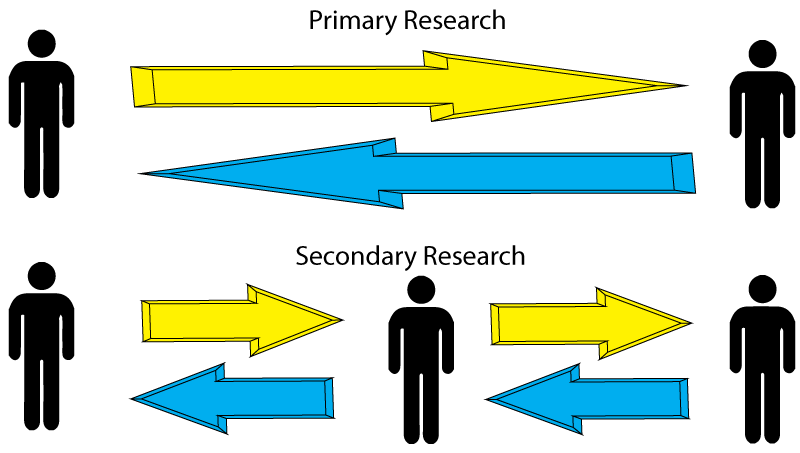
Types of Primary and Secondary Research
Primary research takes many forms
Secondary research also takes many forms
Factors that affect the accuracy of research data
For primary research this could include:

Market Research Analysis
Market research results can be presented in many ways, such as:
- Bar Charts
- Line Charts
- Pie charts
- Tables
Look at the following data tables and use the questions to help you analyse the data. You should then discuss what you think the information is showing you. If you are unsure how to do all of this, visit our store to purchase the revision material!
- Construct a bar chart from the information in table 1.
- Construct a line graph from the information in table 2.
- Construct a pie chart from the information in table 3.
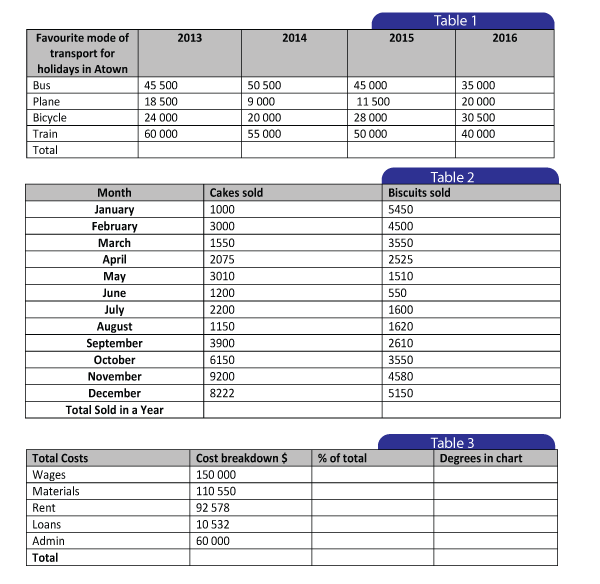
The Marketing Mix
The Marketing Mix: Product
The Marketing Mix is the use of price, promotion, placement and product (the 4 P's) to achieve a firm's marketing aims. Each of these P's is essential to creating a brand, attracting customers and retaining them.
Tasks
http://www.hongkiat.com/blog/wacky-apple-products/ http://www.cnet.com/uk/pictures/all-the-cool-new-gadgets-at-ces-2016-pictures/
Look at the items in the link above:
- Which new products do you think will work out?
- Why do you think Apple are working on products such as these? Give three reasons.
- What might be the disadvantages of adding products to their portfolio?
- Are there any other products you can think of that may improve their sales?
- What image do eah of the products give you of Apple? Are there any it would not want to be associated with?
- Describe the process you think Apple goes through when creating new products, from idea to launch
Packaging is also an important part of the product as it:
- Feeds into the brand image
- Adds a level of protection to the product
- Provides crucial information
Brand Image can be defined as the way in which consumers view the product a firm produces. Watch the video entitled 'Branding and Brand Image' and answer the following questions.
Product Life Cycles
Product Life Cycles are designed to show the stages a product goes through and can be used to see the lifespan of a product (how long it is going to last).
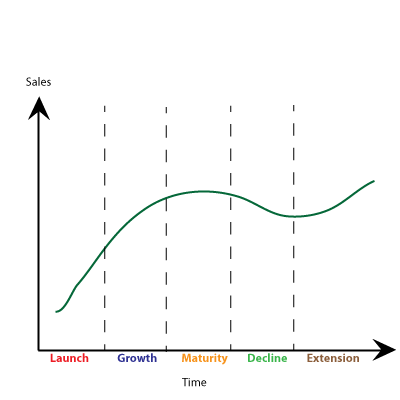
- Launch This is where the product is introduced to the market; it usually takes some time before sales begin to take off. Heavy marketing needed.
- Growth Consumers are now aware of the product and sales soar
- Maturity Sales remain high as the product is established
- Decline New products, competition and time cause sales to fall. If the firm is still counting on the product to sell, then more will need to be spent on promotion.
- ExtensionThis is where the effect of a drop in price or a new promotional campaign are felt, causing sales to rise again.
Tasks
- Explain three ways you think a firm could try and extend the life of a product
- Draw two separate Product Life Cycles; one for a new iPhone and one for a new tractor. How do they compare? How do they differ?
- If you worked in Apple's pricing department, what price would you set your new iphone in each stage?
- If you worked in Apple's promotional department, what price would you set your new iphone in each stage?
- If a product became a sudden trend - like a YoYo - how would its Product Life Cycle look?
- What is the relationship between brand image and a Product Life Cycle?
Remember, all revision notes can be found by looking at our store, or simply click here
The Marketing Mix: Price
Tasks
Look at the video entitled 'Pricing Strategies'
- Explain the concept of Price Skimming
- Explain the concept of Penetration Pricing
- Explain the concept of Status Quo pricing
Read the following article and answer the questions below
http://www.cnbc.com/2014/06/30/amazons-predatory-pricing-questioned.html
- What is predatory pricing?
- What type of firms can engage in predatory pricing?
- Why is predatory pricing seen as a negative thing? Explain two reasons.
- Why is predatory pricing very hard to prove?
Remember, all complete revision notes can be found by heading to our store, or simply click here
Which Price to Choose?
When a firm decides which price to choose it needs to think of the following things:
- Competition: the more firms that are in the industry, the lower the price. If a firm is a monopoly it can charge a high price as no one else produces the product.
- Cost of Production: high costs of production will mean that prices will have to be high, as firms cannot make a loss. Firms wil need to take into a account both fixed and variable costs, as well as taxes (these are explored later)
- Objectives / Profit Margins: a firm that wishes to capture all of the market may decide to put prices low, whereas a firm that wishes to finance a new project may increase prices
- Market Conditions : this involves what the people buying the product are like - will they pay as much as you are asking for? is there a recession?

Price Elasticity of Demand
This is the relationship between a change in price and a change in quantity demanded:
- Inelastic Demand: this means that a percentage change in price leads to a smaller percentage change in quantity demanded. This is good if prices go up as consumption remains roughly the same but bad if prices go down as not many people buy more, even at a lower price. For example in diagram 1, we can see that prices have risen by 30% (p to p1) but quantity demanded only fell by 10%. This is clearly good for the producer. However, if we were to reverse it, and prices fell by 30% with only 10% increase in quantity, that would be bad for the consumer.
- Elastic Demand: this means that a percentage change in price leads to a larger percentage change in quantity demanded. This is good if prices fall, as consumption increases by a large %, meaning more revenue is made. However, if prices go up, then this is bad as it leads to quantity demanded falling greatly, in % terms. For example, on diagram 2 a 5% rise in prices leads to a 10% fall in quantity demanded, leaving the firm with less profits. However if prices were to fall by 5% then quantity demanded would increase by 10%, leading to a risei n prices.
Price Discrimination seeks to make use of elasticities. Price discrimination is charging different prices to different users or market segments for the same product. If you know that someone needs a product, then their demand will be very inelastic. You can therefore put the price up for these people, whilst for people that don't need it or even want it, you could lower the price as their demand is elastic. In each case your revenue would go up. This is done for things such as cinema tickets (pensioners pay less, working earners pay more) or airline tickets. This is sometimes also known as dynamic pricing
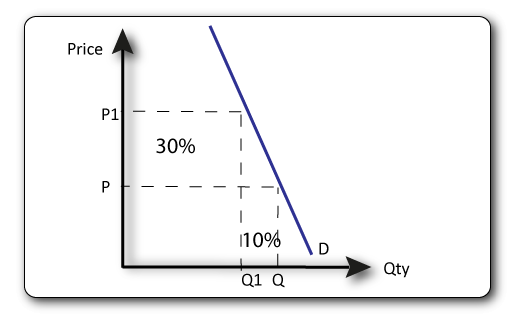
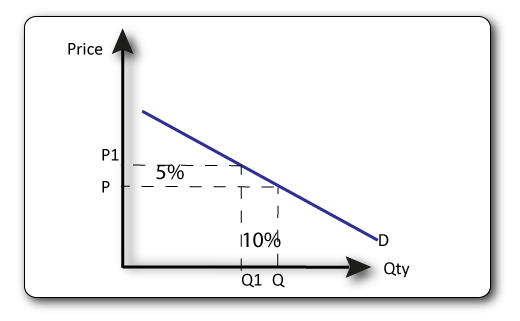
The Marketing Mix: Placement
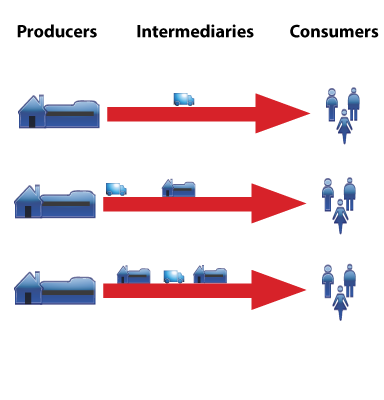
Using the above image explain:
- The difference between Direct and Indirect Distribution
- The role of a wholesaler
- The advantages and disadvantages of direct vs indirect distribution
- What would influence your decision to choose a certain type of distribution channel? Give 5 factors
- Differentiate between channels of distribution and logistics
- Discuss the logistical difficulties present to FedEx and UPS in the video above
The Marketing Mix: Promotion
Promotion
Promotion involves attracting, informing and maintaining customers through visual and non-visual means. We can catagorise promotion as being either above the line (meaning it attempts to reach as many people as possible thorugh mass media, or below the line (meaning it attempts to reach out to specific customer groups or market segements directly
Above the Line Promotional Forms
Below the Line Promotional Forms
For more informtion on these forms and their advantages and disadvantages don't forget to check out our Revision Guide available in the store (or just click here)
Marketing Budgets
- a. What is the total marketing budget estimated to be spent by the marketing department?
- b. What type of promotional activity (above or below the line) are they pursuing most? Explain your answer
- c. A consumer oriented firm is one which focuses on what consumers wants and then makes it. A product oriented firm will make a product and then convince consumers to buy it. Which do you think this company is? Explain your answer
- d. What type of market research does the company spend most on?
- e. How much, as a percentage, does the firm spend on web research, in total? Show your workings
- f. Draw a bar chart to show the break down in the percentage of money allocated to marketing communications
- g. What other marketing costs could be included in the budget?
- h. How could this budget be used as a measurement of
- i. Control
- ii. Performance
Legal Marketing Restraints on a Firm
Any marketing strategy must operate within the law. There are several marketing laws which should be taken into consideration, intended to protect the consumer. These are known as Consumer Protection Laws:
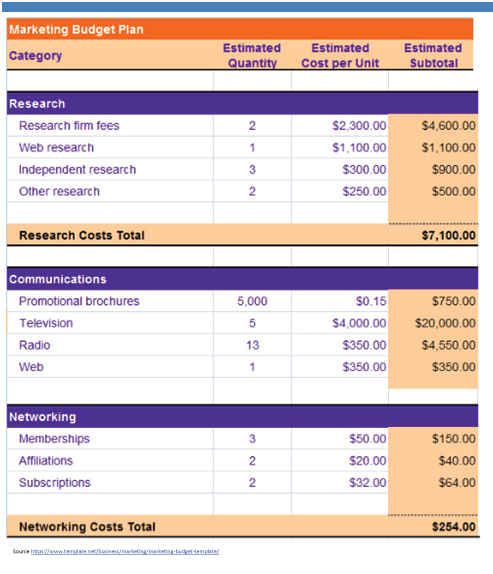
Marketing Strategies

